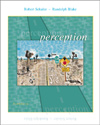In this chapter, we discovered how the sense of touch, working primarily through that remarkable sensory organ the human hand, is capable of fast, highly accurate and subtle discriminations. We discovered that touch owes part of its success to the information it gets from sets of touch receptors whose different characteristics create diverse and complementary perspectives on the world that lies at our fingertips. An equally great part of its success seems to come, though, from the unique information created by the hand's own skilled and highly purposeful exploration of the world. The intimate relationships between manual exploration and the resulting sensory response reminded us of the pervasive connections between perception and action. We also learned about the "dark" side of touch, pain, and saw that pain is a complex sensory experience with intensive and affective overtones. Finally, we saw how controlled, intensive practice could alter cortical organization even into adulthood.
We turn in the next chapter to taste and smell, senses that are important not only as channels for information about the world, but also as providers of particular delight and pleasure. |



 2002 McGraw-Hill Higher Education
2002 McGraw-Hill Higher Education

 2002 McGraw-Hill Higher Education
2002 McGraw-Hill Higher Education